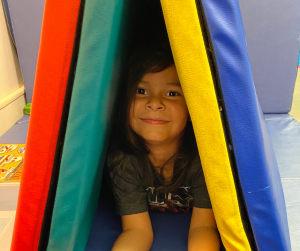A Strengths-Based Approach to Autism Learning Style
(Social Communication)
As time goes on, we continue to learn so much about Autism Spectrum Disorder (ASD). It is vital to continue researching, as 1 in 54 children are diagnosed with ASD every day, according to new biennial data (2020) released by the Centers for Disease Control and Prevention (CDC). It is important to note that self-advocates and allies of the autism community have revealed preference for identity-first language (ie., preference for “autistic person” vs. “person with autism”); thus, this terminology will be utilized throughout the blog. Self-advocates state that they prefer to be called an “autistic person” because it defines the ways in which individuals experience and absorb the world around them. Piggy-backing off this statement, we are going to be exploring a bit more on how autistic people experience the world through their learning styles. Most of the information was obtained by the “Learn Play Thrive Approach to Autism” course. The owner of “Learn Play Thrive” is Meg Proctor, OTR/L.

As Meg Proctor, from “Learn Play Thrive” described, looking through an autistic person’s eyes is different than looking through a neurotypical person’s eyes; however, it is not a deficit. She described a study that took place, which included several groups: a group with neurotypical people, a group with autistic people, and a blended group of neurotypical and autistic people. They all were asked to share information with each other and engage in social situation experiences. The study revealed that there were similar levels of comfort for the neurotypical people group, as well as with the autistic people group. Frustration solely arose when the autistic people and neurotypical people were blended. Findings found that the blended group had more communication breakdowns, which negatively impacted satisfaction levels. In short, a neurotypical person and an autistic person share different perspectives, classified as the “double empathy problem”.
Taken together, an autistic person is asked to do so much work to take on the perspective of neurotypical people, but neurotypical people don’t do as much to take on the perspective of autistic people. It is important to educate ourselves on the learning styles of autistic people, as we want them to feel just as comfortable in this beautiful world. There are a range of learning styles. This blog will talk about the different learning styles of social communication.
Learning Styles of Social Communication
Different Social Skills
Rachel Dorsey is an autistic speech-language pathologist who shared her perspective on the “Learn Play Thrive Approach to Autism” course. The brilliant speaker revealed specific examples of how an autistic person’s social skills are different:
- Conversations
- Autistic people may not like “surface-level” conversations or “small talk”, as much as neurotypical people. They may prefer to dive straight into more deep topics.
- “Neurotypical people like chit chat…[they] like lighter surface-level types of topics to establish that the other person is a safe person before gradually moving on to topics of deeper emotional substance, as the relationships grows… whereas autistic people are so desperate for a really, really deep bond, that they go right into those topics that hold emotional space, and they do that right from the start”
Dorsey explained how these differences can cause communication breakdowns: a neurotypical person may believe an autistic person is oversharing, while autisic people may find those “surface-level conversations’ ‘, as boring.
- Topics
- Dorsey, M.S. CCC-SLP, explained how neurotypical people often engage in conversations regarding a range of topics with back-and-forth questioning/commenting; however, neurotypical people prefer “info-dumping” on a topic that’s exciting to them. They prefer providing a lot of facts. She explained how neurotypical people and autistic people may have their wires crossed with conversational discourse, as neurotypical people may believe that “info-dumping” monopolizes conversations, while autistic people may feel hurt when they don’t feel cared about regarding their monologues on specific subjects.
- Consolement
- Lastly, regarding social skills, she provided an example regarding consolement during hard times. She revealed that when a person is going through a hard time, an autistic person may show empathy by talking about a similar experience to signify, “I get what you’re going through”. However, a neurotypical person may get confused and think, “Why are you talking about yourself right now?”. Thus, if an autistic person is going through a hard time, instead of using more common comments during hard times (e.g., “I’m so sorry”, “[T] ell me more”), offer a story where you have gone through a similar situation.
Joint Attention
Next, Rachel Dorsey, M.S. CCC-SLP talked more on joint attention, which is the shared focus of two individuals on one object. She talked about how it presents differently between neurotypical and autistic people. As many speech-language pathologists may recall, it is often taught as a prerequisite for everything regarding language building. However, she rightfully points out that clients often surprise us; one moment you think they are not paying attention, and suddenly they reveal that they’re more in-tune than we had initially thought. Being an autistic person herself, she says, “I have a hard time orienting to a point… I have to cue myself”. So, how can a neurotypical person help?
- Use specific language
- She stated that specific language is extremely helpful. Rachel provided an example on the difference of hearing “go over there” vs. “go to the corner of the room with…”
- Don’t underestimate peripheral vision
- Just because an autistic person may not be looking directly at an object, their peripheral vision picks up on more than you would think.
- Understand that stimming may be helping
- Stimming, or repetitive/unusual movements or noises, may help an autistic person to auditorily attend.
Social Engagement
Rachel Dorsey expressed that a common opinion is that autistic people don’t want to bond socially; however, she implies that nothing could be further from the truth. She noted that if a person withdraws from social bonding, it can be for many other reasons, but it’s not because they do not want a deep emotional bond. She explained that social withdrawal may be due to:
- Sensory bombardment –
- When an autistic person withdraws due to sensory bombardment, it can help bring them back to a baseline.
- Decreased social desire –
- An autistic person may have less social desire in general; however, that does not mean that they do not appreciate a social bond — it just looks different.
Given all of this information, the idea is to build on an autistic person’s strengths, to help make them more comfortable in this predominantly neurotypical-led world. Possible strengths include:
- Empathy
- Honesty
- Humor
- Relationships with other autistic people
Thank you, “Learn Play Thrive”, owned by Meg Proctor, OTR/L, for compiling amazing information on how we can all work together to be more empathetic in this beautiful world full of diverse individuals. Please check out the course for plentiful more information! https://learnplaythrive.com/approach/
-Andrea Scola, M.S. CCC-SLP, Exceptional Speech Therapy Blog Writer
References:
Information compiled from “Learn Play Thrive” Approach to Autism Course:
(References from course)
Cahil, S. M., Egan, B. E., Seber, J. (2020) Activity- and occupation-based interventions to support mental health, positive behavior, and social participation for children and youth: A syetematic reveiw. American Journal of Occupational Therapy, March 2020, Vol. 74, 7402180020. https://doi.org/10.5014/ajot.2020.038687
Gernsbacher M. A. (2017). Editorial Perspective: The use of person-first language in scholarly writing may accentuate stigma. Journal of child psychology and psychiatry, and allied disciplines, 58(7), 859–861. https://doi.org/10.1111/jcpp.12706
Mesibov, G.B., & Shea, V. (2010). The TEACCH program in the era of evidence-based practice. Journal of Autism & Developmental Disorders, 40 (5). doi: 10.1007/s10803-009-0901-6.
Ryberg, K.H. (2015). Evidence for the implementation of the Early Start Denver Model for Young Children With Autism Spectrum Disorder. Journal of the American Psychiatric Nurses Association, 21(5), 327-37. doi: 10.1177/1078390315608165.
Sanz-Cervera, P., Fernández-Andrés, M. I., Pastor-Cerezuela, G., & Tárraga-Mínguez, R. (2018). The effectiveness of TEACCH intervention in autism spectrum disorder: A review study. Papeles del Psicólogo, 39(1), 40–50.

